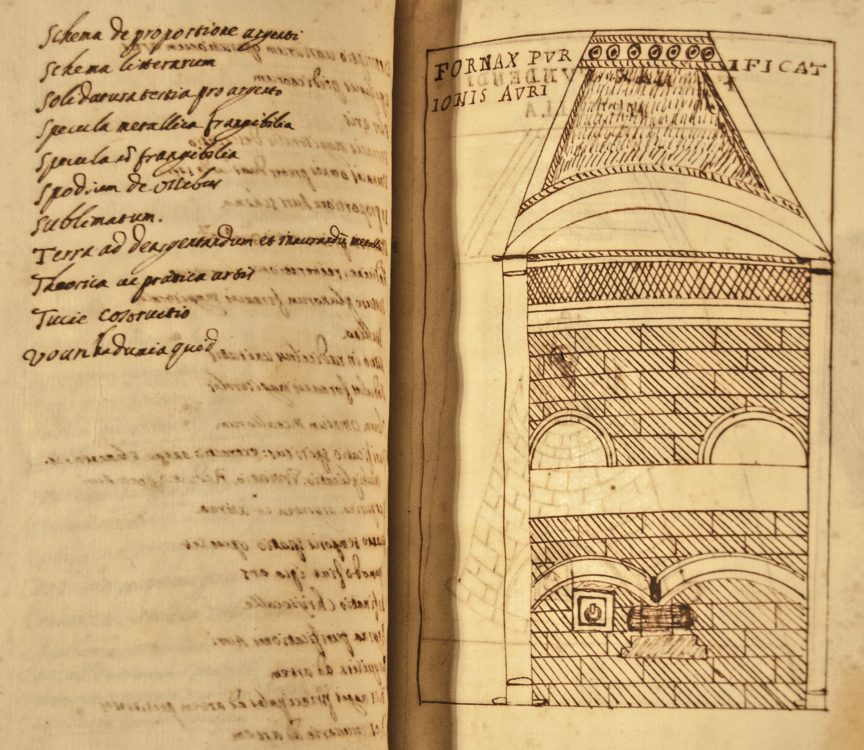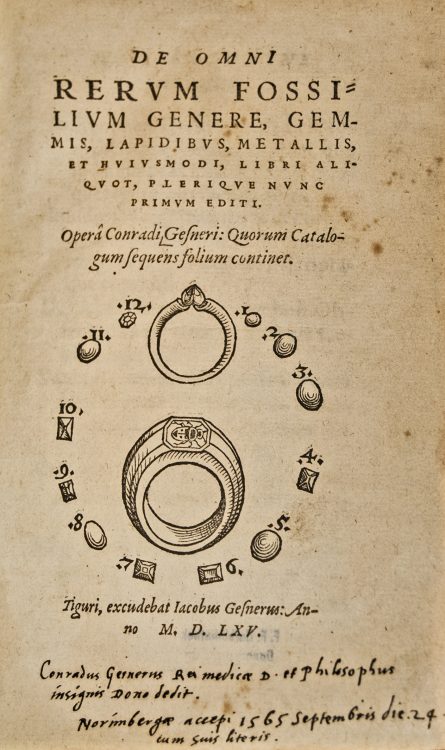Anselmus de Boodt was a Belgian mineralogist and alchemist. His Gemmarum et Lapidum Historia was one of the first attempts to present a systematic description of minerals. De Boodt cataloged about 600 minerals from personal experience, describing their properties and medicinal uses, as well as any known imitations of them. The volume on display is opened to an illustration of what were then known as glossopetrae (“tongue stones”).
De Secretis Naturae Siue Quinta Essentia (“Book of the Secrets of Nature or of the Quintessence”) is an alchemical text that was attributed to the Catalan mystic and poet, Ramon Llull. Llull never actually wrote about alchemy (he actually expressed skepticism about it), but it was a relatively common practice to lend authority to a text by ascribing its authorship to an earlier, respected author. In this case, the alchemical works attributed to Llull were similar enough to his genuine works that their authorship went mostly unquestioned for centuries. This work concerns the Philosopher’s Stone, a legendary incorruptible substance that could transfer its incorruptibility on to other substances. Among the perceived powers of the Philosopher’s Stone were the ability to extend human health and life, to transform base metals into gold, and to remove the imperfections found in precious stones. The textual history of the De Secretis Naturae is incredibly complicated: all of the extant manuscript and print editions have considerable differences, and it is unclear whether any of one of them takes precedence over the other.
Little is known about the origins of this manuscript, which may have served as a working document for studies, research, or experiments. It contains a series of notes about the properties of precious stones, and several tables concerning the properties of metals. It also includes images of furnaces used for the refining of metals.
This is the first edition of the first illustrated work devoted solely to minerals and fossils. It consists of eight separate works by seven authors on fossils, gems, and metals, including the first published catalog of a geological collection. (The catalog also includes an early illustration of one of the cabinets that was used to store geological specimens). The work was edited by the Swiss physician and naturalist, Conrad Gessner, who provided an introduction and commentary on the texts. Gessner’s own contribution to the volume is an early attempt at a geological classification scheme. (It includes, among many other things, one of the first known illustrations of a lead pencil). An inscription on the title page states that this particular copy was a gift from Gessner himself. (Unfortunately, the recipient of the book is not named).


![Raimundi Lulii maiorici philosophi acutissimi, mediciq[ue] celeberrimi, De secretis naturae siue quinta essentia libri duo. : His accesserunt, Alberti Magni summi philosophi, De mineralibus & rebus metallicis libri quin[que]. Quae omnia solerti cura repurgata rerum naturae studiosis recens publicata sunt per M. Gualtherum H. Ryff, Argentinensem. medicum. Raimundi Lulii maiorici philosophi acutissimi, mediciq[ue] celeberrimi, De secretis naturae siue quinta essentia libri duo. : His accesserunt, Alberti Magni summi philosophi, De mineralibus & rebus metallicis libri quin[que]. Quae omnia solerti cura repurgata rerum naturae studiosis recens publicata sunt per M. Gualtherum H. Ryff, Argentinensem. medicum.](https://exhibitions.lib.udel.edu/alchemy/wp-content/uploads/sites/57/2019/11/Raimundi-Lulii-maiorici-philosophi-acutissimi-e1578322124936.jpg)


